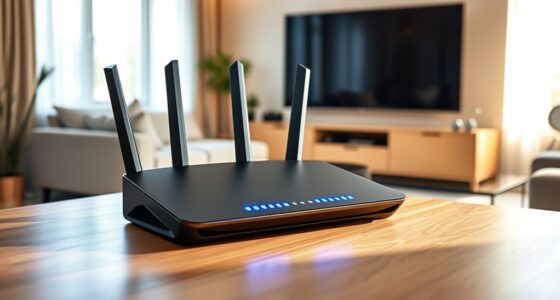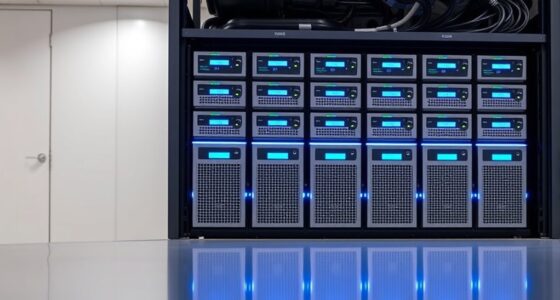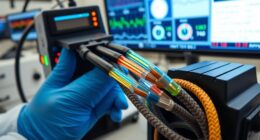If you’re looking to optimize your enterprise Wi-Fi, I recommend checking out top tools like the TREND Networks SignalTEK 10G Pro for troubleshooting, Ubiquiti’s Wi-Fi 6 and Wi-Fi 7 access points, and portable analyzers with TFT screens for quick site assessments. Advanced spectral analysis and environment diagnostics are essential for reliable coverage. For outdoor or long-range needs, options like high-gain antennas and cloud-managed solutions come in handy. Keep exploring to find the best fit for your network.
Key Takeaways
- Choose analyzers supporting WiFi 6 and WiFi 7 standards for future-proof enterprise network optimization.
- Prioritize tools with real-time spectral analysis and channel interference detection capabilities.
- Opt for portable devices with dual-band (2.4 GHz and 5/6 GHz) support for comprehensive environment assessment.
- Select analyzers offering network diagnostics, including signal strength, noise levels, and device interference mapping.
- Ensure compatibility with enterprise security protocols and vendor standards for seamless integration.
TREND Networks SignalTEK 10G Pro Troubleshooter & Tester Kit

If you’re a network technician or system integrator working with high-speed wired and wireless networks, the TREND Networks SignalTEK 10G Pro Troubleshooter & Tester Kit is an essential tool. It helps minimize downtime by simulating real network traffic to test and troubleshoot networks up to 10 Gb/s. The device supports fiber testing, WiFi, and offers built-in PDF reporting, making documentation straightforward. It also verifies PoE power delivery up to 90W, ensuring proper device operation. Plus, it allows you to confirm cabling support for Multi-Gigabit switches, saving time and costs. Cloud integration provides real-time reports, simplifying network management and upgrade validation.
Best For: network technicians, data installers, and system integrators needing accurate testing and troubleshooting of high-speed wired and wireless networks up to 10 Gb/s.
Pros:
- Supports fiber testing, WiFi, and PoE verification up to 90W, ensuring comprehensive network diagnostics
- Built-in PDF reporting and cloud integration streamline documentation and real-time analysis
- Verifies cabling support for Multi-Gigabit switches, saving time and reducing unnecessary replacements
Cons:
- May require familiarity with network standards to utilize advanced features effectively
- Potentially higher cost compared to basic network testers, which might be a consideration for smaller operations
- Device size and complexity could be challenging for users new to high-speed network testing
Ubiquiti Enterprise 7 (E7-US)

The Ubiquiti Enterprise 7 (E7-US) stands out for its support of WiFi 7 with 6 GHz frequency, making it an ideal choice for enterprise networks that demand high capacity and future-proof performance. It offers 10 spatial streams, supporting over 1,000 devices simultaneously, and covers around 185 m² (2,000 ft²). Its real-time spectral analysis and dedicated spectral analyzer radio optimize channel selection and reduce interference. With long-range 6 GHz performance enabled by AFC, it ensures reliable connectivity across large spaces. This device enhances network efficiency and handles multiple devices seamlessly, making it a powerful tool for enterprise WiFi optimization.
Best For: large enterprise networks requiring high capacity, seamless device connectivity, and future-proof WiFi 7 performance.
Pros:
- Supports WiFi 7 with 6 GHz for cutting-edge speed and capacity
- Handles over 1,000 devices simultaneously with 10 spatial streams
- Features real-time spectral analysis and dedicated spectral analyzer radio for optimal channel selection
Cons:
- May be expensive for smaller organizations or home use
- Requires compatible client devices to fully leverage WiFi 7 capabilities
- Setup and configuration can be complex for users unfamiliar with enterprise networking
Ubiquiti Networks E7 Campus (E7-Campus)
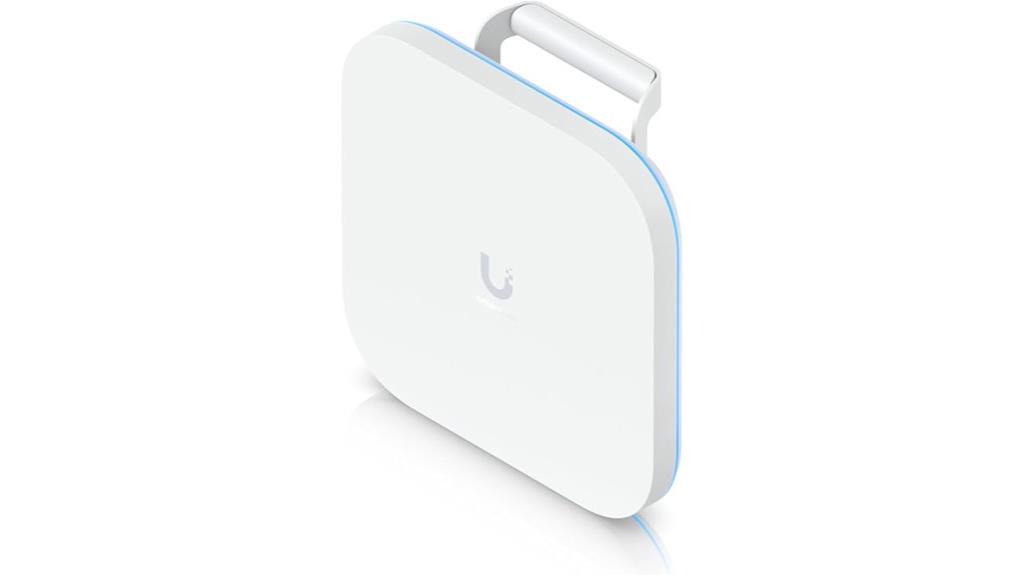
For enterprise networks demanding high-performance Wi-Fi analysis, the Ubiquiti Networks E7 Campus (E7-Campus) stands out with its support for WiFi 7 and 6 GHz frequencies. Its long-range 6 GHz performance and AFC guarantee reliable connectivity across large campuses. The device features a directional high-gain antenna array and 10 spatial streams, boosting coverage and throughput. Real-time spectral analysis with a dedicated spectral analyzer radio helps optimize channel selection, while PRISM RF filtering technology provides high selectivity. This combination makes the E7-Campus a powerful tool for detailed Wi-Fi environment assessment and performance optimization.
Best For: enterprises and network professionals seeking advanced Wi-Fi analysis and high-performance connectivity across large campuses using WiFi 7 and 6 GHz frequencies.
Pros:
- Supports WiFi 7 with 6 GHz and AFC for future-proof high-speed connectivity
- Features directional high-gain antenna array and 10 spatial streams for extensive coverage and throughput
- Equipped with real-time spectral analysis, dedicated spectral analyzer radio, and PRISM RF filtering for precise environment assessment
Cons:
- Likely to be expensive due to advanced features and enterprise-grade capabilities
- May require specialized knowledge to fully leverage spectral analysis and filtering tools
- Larger physical footprint could limit installation options in constrained spaces
Ubiquiti Dream Wi-Fi 6 IEEE 802.11ax Ethernet Wireless Router
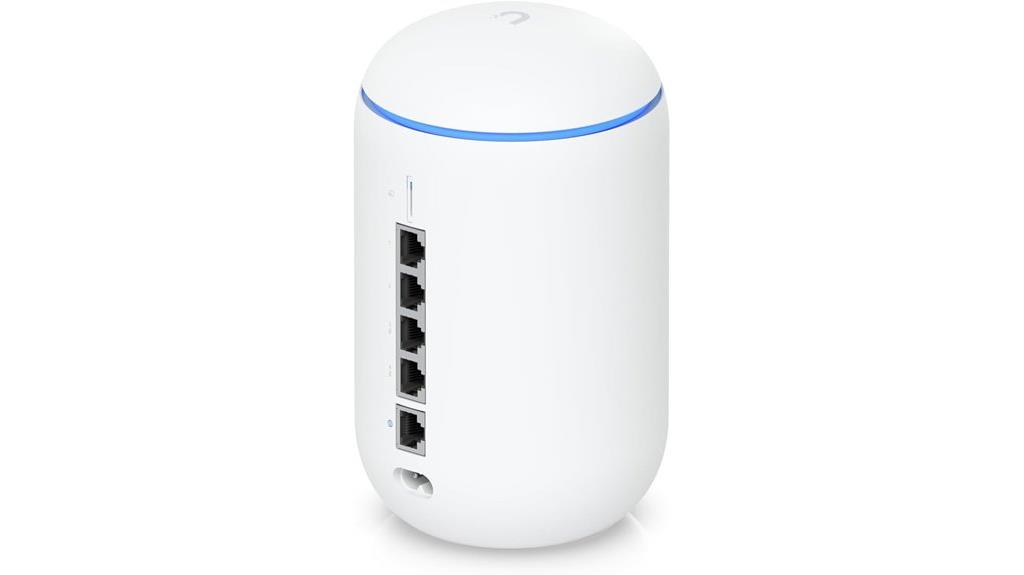
Designed for high-performance enterprise environments, the Ubiquiti Dream Wi-Fi 6 router leverages the IEEE 802.11ax standard to deliver reliable, high-speed wireless connectivity across multiple devices simultaneously. It supports Wi-Fi 6, ensuring enhanced network efficiency, reduced latency, and a seamless experience for computers, printers, and smart devices. The router features a Gigabit Ethernet port for ultra-fast wired connections, ideal for bandwidth-intensive tasks. Its single cable power and data transmission simplify installation and minimize clutter. Overall, this router combines advanced wireless technology with robust wired options, making it an excellent choice for demanding professional networks.
Best For: small to medium-sized professional or home office environments requiring high-speed, reliable Wi-Fi 6 connectivity and seamless wired integration.
Pros:
- Supports Wi-Fi 6 (IEEE 802.11ax) for faster, more efficient wireless performance with multiple devices.
- Equipped with Gigabit Ethernet port for ultra-fast wired connections, ideal for bandwidth-intensive tasks.
- Single cable power and data transmission simplifies installation and reduces clutter.
Cons:
- May be overkill for basic internet needs or small households with minimal device requirements.
- Higher price point compared to standard Wi-Fi 5 routers.
- Limited details on advanced security features in the provided description.
Analyzer 2.4G/5G Network Analyzer with TFT Screen
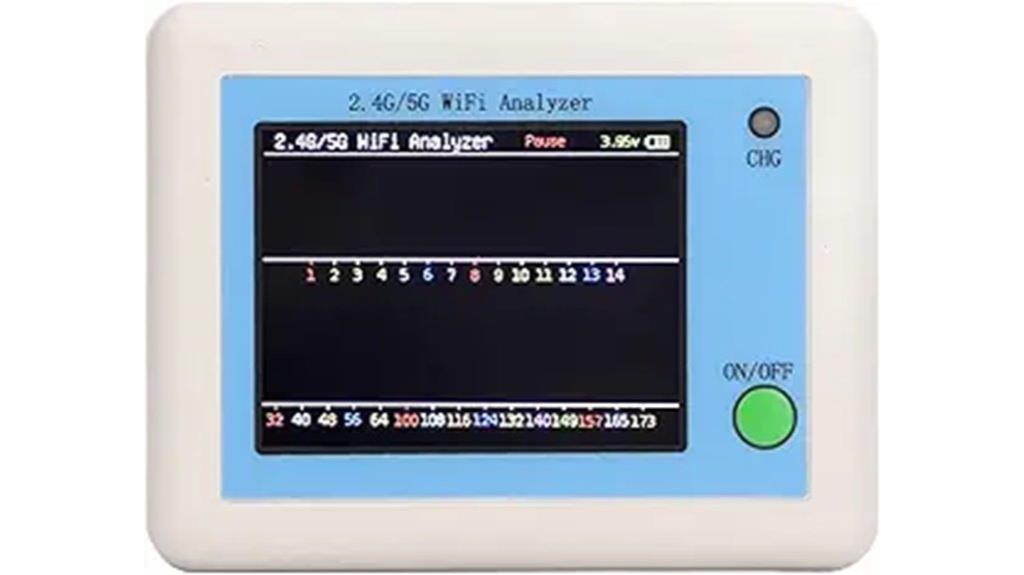
If you need a portable and easy-to-use tool for on-the-go network analysis, the Analyzer 2.4G/5G Network Analyzer with TFT Screen is an excellent choice. It supports both 2.4 GHz and 5 GHz bands and features a bright 2.4-inch TFT color display for clear data visualization. The device includes light indicators, battery status, and a long standby time, making it perfect for fieldwork. With effortless channel switching, fine-tuning, and frequency point viewing, it helps reduce interference and optimize signal quality. Its compact design, simple charging via TYPE C, and user-friendly interface guarantee reliable performance during extended network testing sessions.
Best For: Professionals and field technicians seeking a portable, easy-to-use device for efficient 2.4 GHz and 5 GHz network analysis and optimization.
Pros:
- Supports both 2.4G and 5G frequency bands for versatile network testing.
- Features a bright 2.4-inch TFT color display for clear and easy data visualization.
- Compact, lightweight design with long standby time and simple Type C charging for convenience.
Cons:
- Limited battery capacity may require frequent recharging during extended use.
- Small screen size might be less ideal for detailed data analysis compared to larger displays.
- May lack advanced features needed for complex network troubleshooting beyond basic analysis.
Digi Connect EZ 4-4-Port Serial Server with Dual Ethernet and Wi-Fi Connectivity
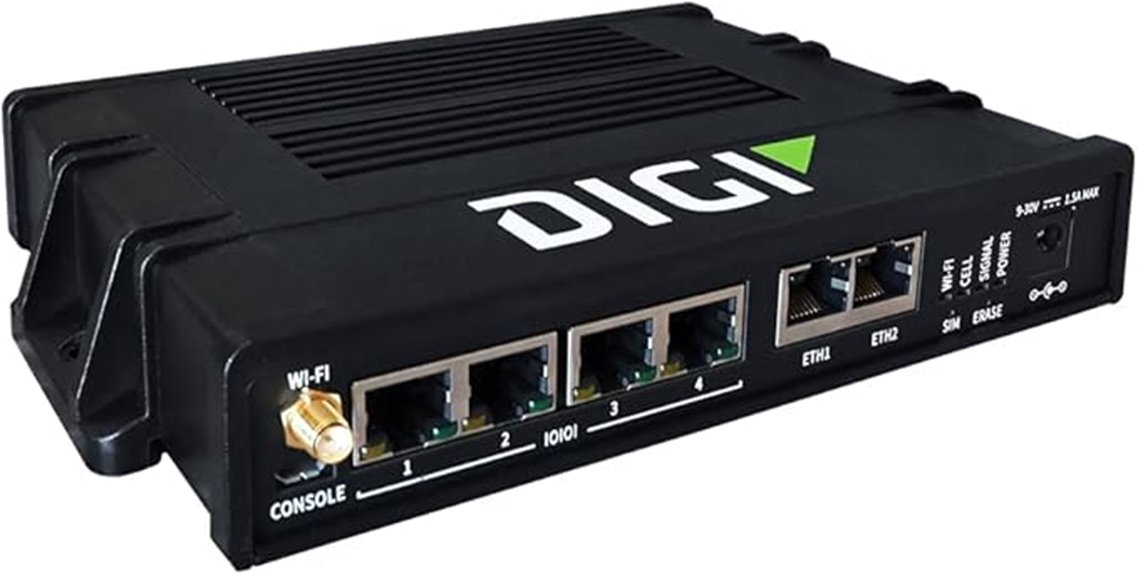
The Digi Connect EZ 4-4-Port Serial Server stands out as an ideal solution for enterprise networks requiring robust, versatile connectivity. It provides four RJ45 serial ports supporting RS-232, RS-422, and RS-485, all selectable via software. Dual Ethernet ports enable reliable gigabit connections, while integrated Wi-Fi supports dual-band 802.11a/b/g/n/ac, functioning simultaneously as client and access point for up to 10 clients. Management is extensive, with options like Digi Remote Manager, SNMP v3, and local Web UI or CLI. Security features include WPA-3, LDAP, and RADIUS, ensuring secure remote access. Its hardware specs support smooth operation and flexibility across diverse network environments.
Best For: organizations seeking a reliable, secure, and versatile serial-to-network solution with integrated Wi-Fi and multi-protocol support for remote device management.
Pros:
- Supports multiple serial protocols (RS-232, RS-422, RS-485) with software-selectable modes for flexible connectivity.
- Dual Gigabit Ethernet ports and dual-band Wi-Fi enable high-speed, redundant, and wireless network access.
- Extensive management options including Digi Remote Manager, SNMP v3, Web UI, CLI, and security protocols like WPA-3, LDAP, and RADIUS.
Cons:
- May be complex to configure for users unfamiliar with network and serial device management.
- Higher cost compared to simpler serial servers lacking Wi-Fi or dual Ethernet capabilities.
- Physical size and multiple features could require more space and power in deployment environments.
Fluke Networks AirCheck-LE Wi-Fi Tester for Law Enforcement

Law enforcement professionals seeking a quick, reliable way to assess wireless networks in the field will find the Fluke Networks AirCheck-LE Wi-Fi Tester to be an indispensable tool. It instantly detects whether networks are open or secured, supporting all Wi-Fi standards (802.11a/b/g/n). Its external directional antenna helps locate signal strength and security settings inside buildings, providing immediate insights. The device is simple to operate, offering rapid security status checks and device location capabilities. This allows officers to make informed decisions confidently, whether for warrant execution or locating unauthorized devices. Compact and easy to use, the AirCheck-LE streamlines digital investigations and enhances field efficiency.
Best For: law enforcement professionals needing quick, reliable wireless network assessments and device location capabilities in the field.
Pros:
- Supports all Wi-Fi standards (802.11a/b/g/n) for comprehensive compatibility
- External directional antenna aids in locating signal strength and security settings inside buildings
- Simple, rapid operation facilitates quick decision-making during investigations
Cons:
- May require training for optimal use of security and device tracking features
- Limited to Wi-Fi network assessment; does not analyze other wireless signals
- The device’s effectiveness depends on environmental conditions and signal obstructions
Cambium Networks ePMP 5 GHz Force 400C Subscriber Module

For network providers seeking high-capacity, long-range wireless connections, the Cambium Networks ePMP 5 GHz Force 400C Subscriber Module stands out with its 1 Gbps throughput and peak gain of 25 dBi. Designed for outdoor use, it supports interference-tolerant point-to-multipoint and point-to-point links, compatible with large dishes or horn antennas. Its spectral efficiency is boosted by 1024 QAM modulation and 80 MHz channels, ensuring reliable, scalable performance over extended distances. Managed via the cloud-based cnMaestro system, it offers remote diagnostics, simplified deployment, and robust security with 128-bit AES encryption, making it ideal for enterprise and community connectivity.
Best For: network service providers seeking high-capacity, long-range wireless connectivity for enterprise or community networks.
Pros:
- Supports up to 1 Gbps throughput for high-capacity applications
- Long-range capabilities with 25 dBi peak gain and compatibility with large dishes or horn antennas
- Cloud-managed via cnMaestro for remote diagnostics, deployment, and monitoring
Cons:
- Designed primarily for outdoor use, limiting indoor deployment options
- Requires expertise for installation and configuration of external antennas and connectors
- Regulatory compliance and security features are US-specific, which may limit international deployment
NF-8506 Network Cable Tester with IP Scanner, PING, TDR, and Toner for RJ11/RJ45 LAN Ethernet Cable
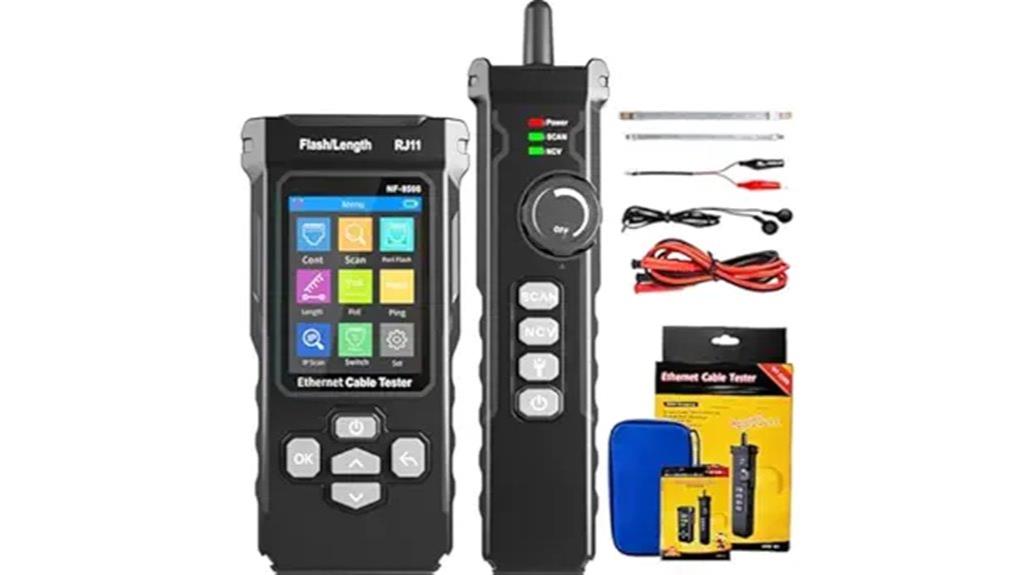
If you’re responsible for maintaining or troubleshooting enterprise networks, the NF-8506 Network Cable Tester stands out as an essential tool thanks to its all-encompassing testing features. It offers IP scanning, PING, TDR, and toner functions for RJ11 and RJ45 Ethernet cables, making it versatile for cable verification and fault detection. It measures cable length, detects shorts or interruptions, and tests network connectivity and speed. The device also identifies PoE devices, checks port status, and supports network diagnostics. Its compact design, LED cable tracing, and comprehensive capabilities make it ideal for network engineers needing quick, reliable insights into cable and network health.
Best For: network technicians, IT professionals, and anyone responsible for maintaining or troubleshooting enterprise or home networks who need a versatile and reliable cable tester and network diagnostic tool.
Pros:
- Multifunctional with IP scanning, PING, TDR, POE detection, and network speed testing capabilities.
- Supports testing for a wide range of Ethernet cables (RJ11, RJ45, CAT5, CAT6) with accurate fault location and cable length measurement.
- Compact, portable design with LED cable tracing and port indicators for easy use in dark or tight spaces.
Cons:
- May have a learning curve for users unfamiliar with advanced network testing features.
- Limited to certain cable types and standards, possibly requiring additional tools for specialized testing.
- Battery life or power options are not specified, which could impact prolonged use in the field.
Network RJ45 Tester for Ethernet and POE Power Checking
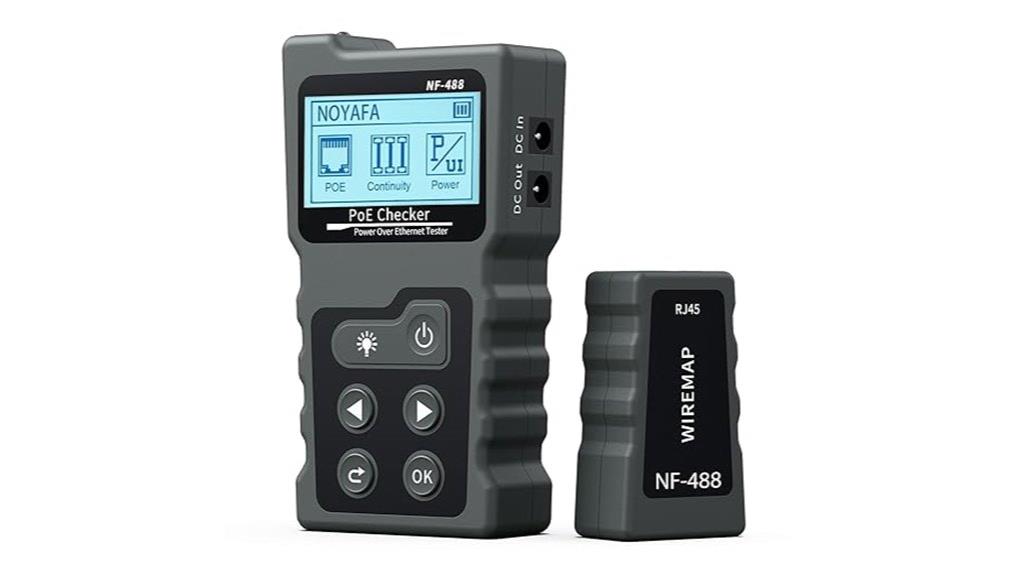
Looking to quickly diagnose Ethernet and PoE issues in your enterprise network? A network RJ45 tester is essential. It checks cables for shorts, crossovers, and open circuits, compatible with CAT5 and CAT6 cables, helping identify performance problems fast. It also tests PoE standards like af and at, verifying power voltage, polarity, and modes, including non-standard devices. With loop-back tests and power measurements up to 180W, it pinpoints connectivity or power issues efficiently. The LCD display with adjustable backlight makes sure clear readings, even in dark environments. This versatile tool streamlines troubleshooting, saving time and reducing downtime for your network.
Best For: IT professionals and network technicians seeking a comprehensive, easy-to-use tool for diagnosing Ethernet and PoE issues in enterprise environments.
Pros:
- Combines cable testing, PoE analysis, and power measurement in a single device for versatile troubleshooting.
- LCD screen with adjustable backlight ensures clear readings in various lighting conditions.
- Ergonomic design with a top-mounted light enhances usability in dark or tight spaces.
Cons:
- May be more expensive than basic cable testers due to its multifunctional features.
- Requires some technical knowledge to interpret advanced PoE and power measurements accurately.
- Limited to testing Ethernet cables up to CAT6 and standard PoE standards, which might not cover all future network technologies.
NetAlly SFP-100FX 100 Mbps Fiber SFP Transceiver with DDM

Are you seeking a reliable way to guarantee your fiber optic network’s performance and diagnostics? The NetAlly SFP-100FX 100 Mbps Fiber SFP Transceiver with DDM is designed for that purpose. It supports 100BASE-FX fiber transmission with multimode compatibility and features a compact SFP form factor with an LC connector. Built for use with the NetAlly LinkRunner AT, it offers precise measurement and diagnostics through Digital Diagnostic Monitoring (DDM). Its sturdy design from the Philippines ensures dependable connectivity, making it ideal for network testing and fiber deployment. This transceiver enhances your ability to monitor, troubleshoot, and optimize fiber optic links efficiently.
Best For: system designers and network technicians seeking reliable fiber optic testing and diagnostics with precise measurement capabilities.
Pros:
- Supports 100BASE-FX multimode fiber transmission for versatile deployment
- Compact SFP form factor with LC connector for easy integration
- Includes Digital Diagnostic Monitoring (DDM) for detailed network diagnostics
Cons:
- Limited to 100 Mbps fiber speeds, not suitable for higher bandwidth requirements
- Designed primarily for use with NetAlly LinkRunner AT, reducing compatibility with other devices
- Requires fiber optic infrastructure and compatible network equipment for optimal use
PoE Tester Gen2.5 by PoE Texas, Power Over Ethernet Network Cable Tester

The PoE Tester Gen2.5 by PoE Texas stands out as an essential tool for network professionals who need a reliable, portable solution for diagnosing Power over Ethernet issues. Its compact, ergonomic design makes it easy to carry and use in the field, drawing power directly from the network cable. The device accurately measures voltage, current, and power consumption, supporting the latest PoE standards like IEEE 802.3at and 802.3bt. It can verify power delivery at remote locations and diagnose issues such as insufficient voltage or faulty equipment. Overall, its multifunctionality and ease of use make it an invaluable diagnostic tool for ensuring reliable PoE deployment in enterprise networks.
Best For: network technicians and IT professionals who require a portable, accurate tool for diagnosing PoE issues in enterprise and field environments.
Pros:
- Compact, ergonomic design for easy portability and field use
- Supports latest PoE standards like IEEE 802.3at and 802.3bt for comprehensive diagnostics
- Draws power directly from Ethernet cables, eliminating the need for batteries
Cons:
- Does not pass all layer 1 signaling, which may affect some device boot processes
- May not measure current load accurately for certain devices
- Slight display flickering reported by some users, though generally reliable
Honeywell Granit 1980i Industrial Scanner
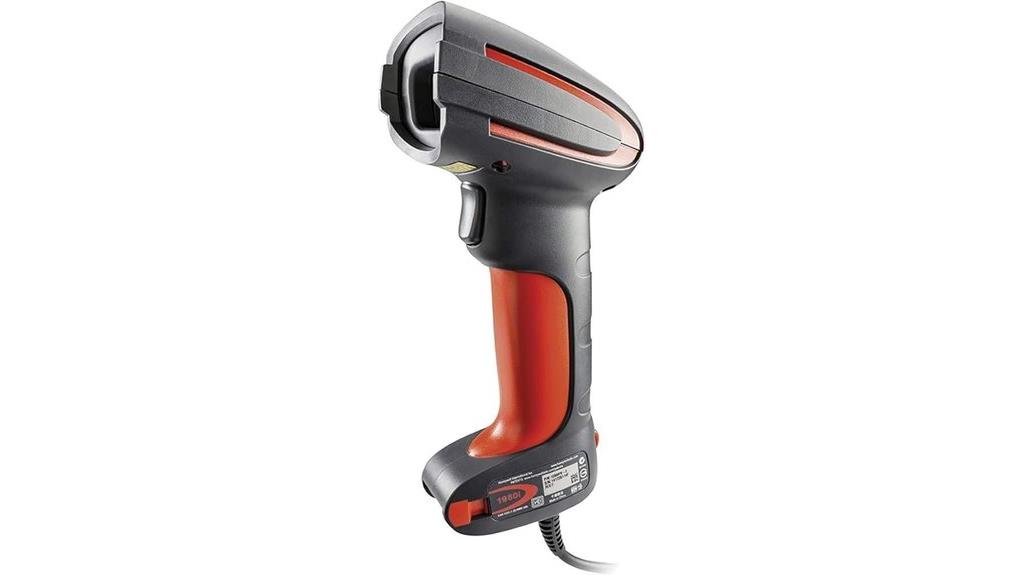
For industrial environments that demand reliable, long-range barcode scanning, the Honeywell Granit 1980i Industrial Scanner stands out with its full-range area-imaging technology, capable of reading both 1D and 2D barcodes from as close as 6 inches up to over 50 feet. Its robust design handles harsh conditions, reading low-quality paper codes at arm’s length and retroreflective codes from warehouse beams, boosting operator productivity. Weighing just 1.34 pounds, it connects via USB over a 49-foot cable, ensuring seamless integration into demanding workflows. This scanner delivers dependable, versatile performance across diverse industrial applications, maximizing efficiency in challenging environments.
Best For: industrial environments requiring reliable, long-range barcode scanning in demanding conditions.
Pros:
- Capable of reading both 1D and 2D barcodes from over 50 feet away, enhancing flexibility.
- Robust design suited for harsh industrial environments, ensuring durability.
- Full-range area-imaging technology provides versatile scanning from close to long distances.
Cons:
- May be heavier or bulkier compared to handheld scanners, potentially affecting ease of use.
- Requires a USB cable for connectivity, limiting wireless mobility.
- Higher price point reflecting its industrial-grade durability and long-range capabilities.
Smart Energy Monitor with WiFi and Current Transformers

If you’re managing energy consumption in a commercial or industrial setting, the Smart Energy Monitor with WiFi and Current Transformers provides a real-time, detailed view of your electrical parameters. It uses two 80A CT clamps to measure current, supports AC90-250V, and tracks power flow from solar and grid sources. The device records data hourly, daily, and monthly, with remote access via the Tuya or SMART LIFE app for monitoring and control. While installation is straightforward and hardware is reliable, some limitations include basic reporting and data export restrictions. Overall, it offers a solid solution for instant energy insight, though advanced analytics often require a subscription.
Best For: commercial and industrial users seeking real-time energy monitoring and management of solar and grid power flow through a reliable WiFi-enabled device.
Pros:
- Supports comprehensive electrical parameter monitoring including voltage, current, power factor, active power, and frequency.
- Easy installation with stable WiFi connectivity and solid hardware design.
- Enables remote access and control via the Tuya or SMART LIFE app for convenient energy management.
Cons:
- Limited in generating detailed custom reports or exporting granular historical data without a subscription.
- Some units may experience hardware inconsistencies like dead channels or inaccurate readings across clamps.
- Basic app interface and reporting features may not satisfy users needing advanced analytics or detailed breakdowns.
Upgraded NanoVNA-H4 Vector Network Analyzer

Powered by its upgraded firmware and precise measurement capabilities, the NanoVNA-H4 Vector Network Analyzer is ideal for RF professionals who need reliable, portable testing in the field. Its 4-inch handheld design, 1950mAh battery, and versatile connectivity options make it perfect for antenna and RF component measurements up to 1.5GHz. Equipped with a built-in SD card slot, SMA calibration kits, and a clear LCD display, it simplifies data storage and analysis. The device supports PC control via NanoVNASaver software, enabling advanced plotting of S-parameters, SWR, and TDR. Its affordability, portability, and accurate performance make it a valuable tool for on-the-go RF testing.
Best For: RF hobbyists, amateur radio operators, and professionals needing portable, accurate antenna and RF component measurements up to 1.5GHz.
Pros:
- Compact, handheld design with a clear LCD display for easy field operation
- Supports extended frequency range up to 1.5GHz with high dynamic range and measurement accuracy
- Versatile connectivity including USB, Type-C, and SD card for data storage and sharing
Cons:
- Occasional menu glitches due to touchscreen clearance issues, requiring minor hardware modifications
- Compatibility issues on Mac OS limit software integration for Mac users
- Slight learning curve for beginners unfamiliar with VNA operation and firmware updates
Factors to Consider When Choosing a Wi‑Fi Analyzer for Enterprise Networks

When selecting a Wi‑Fi analyzer for enterprise networks, I focus on key factors like coverage, compatibility, and analysis tools. It’s crucial to take into account how well the device detects interference and manages multiple devices. By prioritizing these points, I can ensure the analyzer meets the network’s complexity and performance needs.
Coverage and Range
Choosing a Wi-Fi analyzer with sufficient coverage and range is crucial for effective network assessment in large enterprise environments. The coverage area determines how well you can evaluate signal quality and interference across extensive spaces. Devices supporting 6 GHz Wi-Fi 7 typically cover around 185 m² (2,000 ft²), allowing comprehensive analysis within large buildings. Long-range performance features like AFC (Automatic Frequency Control) help detect signals over greater distances, essential for troubleshooting remote or hard-to-reach access points. High-gain antennas and multiple spatial streams further improve monitoring capabilities, especially in complex environments with obstacles or thick walls. Keep in mind that physical factors like building materials and obstacles can impact actual coverage, so choosing analyzers with adjustable sensitivity and higher transmission power ensures more reliable results across your entire network.
Compatibility With Standards
To guarantee your Wi-Fi analyzer remains effective as network standards evolve, it is vital to verify that it supports the latest IEEE specifications like 802.11ax (Wi-Fi 6) and 802.11be (Wi-Fi 7). This guarantees future-proof compatibility and allows you to analyze cutting-edge networks. The device should also operate across all relevant frequency bands—2.4 GHz, 5 GHz, and 6 GHz—for extensive coverage. Support for various modulation schemes, channel widths, and security protocols like WPA3 is essential to accurately assess network configurations. Additionally, it needs to interpret and troubleshoot networks using standards such as DFS, MU-MIMO, and OFDMA. Compatibility with infrastructure components from multiple vendors guarantees broad applicability across diverse enterprise environments, maximizing your investment.
Spectral Analysis Tools
Spectral analysis tools play a vital role in ensuring your Wi-Fi network performs efficiently amidst growing complexity and interference. These tools provide real-time visualization of signal strength, interference, and noise across multiple frequency bands like 2.4 GHz and 5 GHz. They help identify overlapping channels and spectral congestion, enabling me to select the best channels for better performance and less interference. Advanced spectral analyzers include dedicated RF radios and filtering technologies such as PRISM RF filtering, which improve selectivity and accuracy in busy RF environments. They also support troubleshooting by detecting interference sources like radar, Bluetooth, or other non-Wi-Fi signals that can degrade network quality. Performing spectral scans across Wi-Fi bands is essential for designing, deploying, and maintaining high-capacity enterprise networks with minimal interference.
Device Management Features
Effective device management is vital when selecting a Wi-Fi analyzer for enterprise networks, as it guarantees seamless oversight and control across multiple units. A good analyzer should offer centralized management, allowing me to configure, monitor, and update devices remotely. Real-time dashboards and automated alerts help me quickly identify and resolve issues, keeping the network running smoothly. Detailed logs assist troubleshooting and performance optimization. Integration with cloud platforms enables scalable oversight, simplifies deployment, and enforces consistent policies across large environments. Support for multi-user access with role-based permissions ensures secure management, restricting control to authorized personnel. Advanced analyzers also provide remote firmware upgrades and diagnostics, reducing the need for onsite visits and minimizing downtime, which is vital for maintaining an efficient and reliable enterprise network.
Interference Detection Capabilities
When choosing a Wi-Fi analyzer for enterprise networks, one of the most critical factors is its interference detection capability. I look for tools that perform real-time spectral analysis to spot overlapping channels and noise sources in the 2.4 GHz and 5 GHz bands. High-resolution analyzers with PRISM RF filtering technology help me distinguish between multiple interference signals, enabling precise channel optimization. It’s also essential that the analyzer automatically detects non-Wi-Fi interference sources like microwave ovens, Bluetooth devices, and other electronics. Visualizing interference patterns and understanding their impact on signal quality allows me to implement targeted mitigation strategies effectively. Additionally, continuous monitoring features that alert me to interference fluctuations over time ensure stable, high-performance wireless environments for my enterprise network.
Frequently Asked Questions
How Do Wi-Fi Analyzers Differ for Small Businesses Versus Large Enterprises?
Wi-Fi analyzers for small businesses are typically simpler and more affordable, focusing on basic network health and coverage. For large enterprises, these tools are more advanced, offering detailed insights, real-time monitoring, and extensive spectrum analysis. I find that enterprise analyzers are essential for managing complex networks, whereas small business solutions are great for quick diagnostics. The key difference lies in scale, depth of analysis, and features tailored to each environment’s needs.
Can Wi-Fi Analyzers Detect Hidden or Rogue Networks?
Absolutely, Wi-Fi analyzers are like digital detectives. They can spot hidden or rogue networks lurking in your environment, often before you even realize they’re there. These tools scan the airwaves, flagging unauthorized connections that could steal your bandwidth or compromise security. So, if you’re serious about security, investing in a good analyzer means you’re basically hiring a tech-savvy sniffer dog to keep your network safe from sneaky intruders.
What Security Features Should I Look for in a Wi-Fi Analyzer?
When choosing a Wi-Fi analyzer, I look for strong security features like rogue access point detection, encryption analysis, and vulnerability scanning. These tools help me identify unauthorized networks, assess encryption protocols, and find potential security gaps. I also value real-time alerts and detailed reporting to stay ahead of threats. Ultimately, a good analyzer should give me clarity and control over my network’s security, preventing malicious intrusions before they happen.
How Often Should Enterprise Wi-Fi Networks Be Analyzed and Optimized?
I recommend analyzing and optimizing your enterprise Wi-Fi network at least monthly, but more frequently if you experience issues or see performance drops. Regular checks help identify interference, security threats, or capacity problems before they impact users. Keep monitoring continuously with automated tools, and perform deeper assessments quarterly or after significant network changes. Staying proactive guarantees your network runs smoothly, providing reliable connectivity for everyone.
Are Portable Wi-Fi Analyzers Suitable for Remote or Outdoor Network Troubleshooting?
Yes, portable Wi-Fi analyzers are perfect for remote or outdoor troubleshooting. I’ve used them on construction sites and outdoor events, and they’re lightweight and easy to carry. These tools quickly identify interference, signal strength issues, and dead zones without needing a fixed setup. They’re reliable companions when you’re away from the office, helping you diagnose network problems on the spot and keep connectivity smooth anywhere you go.
Conclusion
Choosing the right Wi-Fi analyzer is like tuning a finely crafted instrument—you want everything to harmonize perfectly. With the right tool, you can navigate the complex symphony of enterprise networks, ensuring smooth, reliable connectivity. Whether you’re troubleshooting or optimizing, the right analyzer guides you through the noise, turning chaos into clarity. So, take your time, pick wisely, and let your network sing in perfect harmony.



